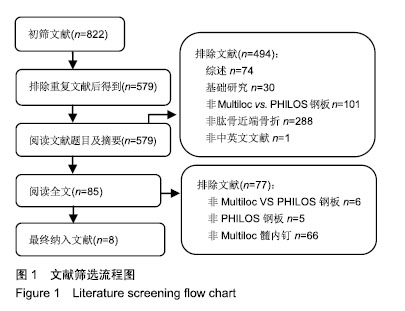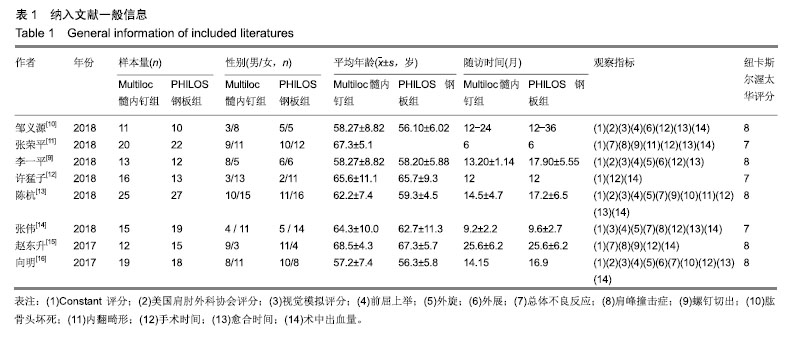Chinese Journal of Tissue Engineering Research ›› 2019, Vol. 23 ›› Issue (36): 5896-5904.doi: 10.3969/j.issn.2095-4344.1961
Multiloc intramedullary nail versus PHILOS locking plate in the treatment of proximal humerus fracture: a meta-analysis
- 1Second Clinical Medical College, Guangzhou University of Chinese Medicine, Guangzhou 510405, Guangdong Province, China; 2Department of Orthopedics, Second Affiliated Hospital of Guangzhou University of Chinese Medicine, Guangzhou 510006, Guangdong Province, China
-
Online:2019-12-28Published:2019-12-28 -
Contact:Su Haitao, Master, Chief physician, Department of Orthopedics, Second Affiliated Hospital of Guangzhou University of Chinese Medicine, Guangzhou 510006, Guangdong Province, China -
About author:Fan Zhirong, Master candidate, Second Clinical Medical College, Guangzhou University of Chinese Medicine, Guangzhou 510405, Guangdong Province, China -
Supported by:the 2018 Guangdong Basic and Applied Research (Provincial Natural Science Fundation) Project, No. 2018A030313694 (to JT)
CLC Number:
Cite this article
Fang Zhirong, Jiang Tao, Hong Weiwu, Huang Yongquan, Peng Jiajie, Liu Zitao, Zhou Lin, Liang Yihao, Su Haitao. Multiloc intramedullary nail versus PHILOS locking plate in the treatment of proximal humerus fracture: a meta-analysis[J]. Chinese Journal of Tissue Engineering Research, 2019, 23(36): 5896-5904.
share this article

2.2 Meta分析结果 2.2.1 肩关节功能评分 (1)肩关节Constant评分:共有8篇文献报道了末次随访肩关节Constant评分[9-16],异质性检验结果提示组间异质性较小(P=0.53,I2=0%),采用固定效应模型合并效应量。Meta分析结果显示,Multiloc髓内钉组在肩关节Constant评分方面优于PHILOS钢板组,2组间差异有显著性意义[MD=1.98(0.65,3.31),P=0.004],见图2。 (2)美国肩肘外科协会评分:共有4篇文献报道了末次随访美国肩肘外科协会评分[9-10,13,16],异质性检验结果提示组间异质性较小(P=0.46,I2=0%),采用固定效应模型合并效应量。Meta分析结果显示,Multiloc髓内钉组在美国肩肘外科协会评分方面优于PHILOS钢板组,2组间差异有显著性意义[MD=3.59(1.61,5.57),P=0.000 4],见图3。 (3)目测类比评分:共有5篇文献报道了末次随访目测类比评分[9-10,13-14,16],异质性检验结果提示组间异质性较小(P=0.45,I2=0%),采用固定效应模型合并效应量。Meta分析结果显示,Multiloc髓内钉组在减少肩关节疼痛方面与PHILOS钢板组差异无显著性意义[MD=-0.08(-0.27,0.12),P=0.42],见图4。 "
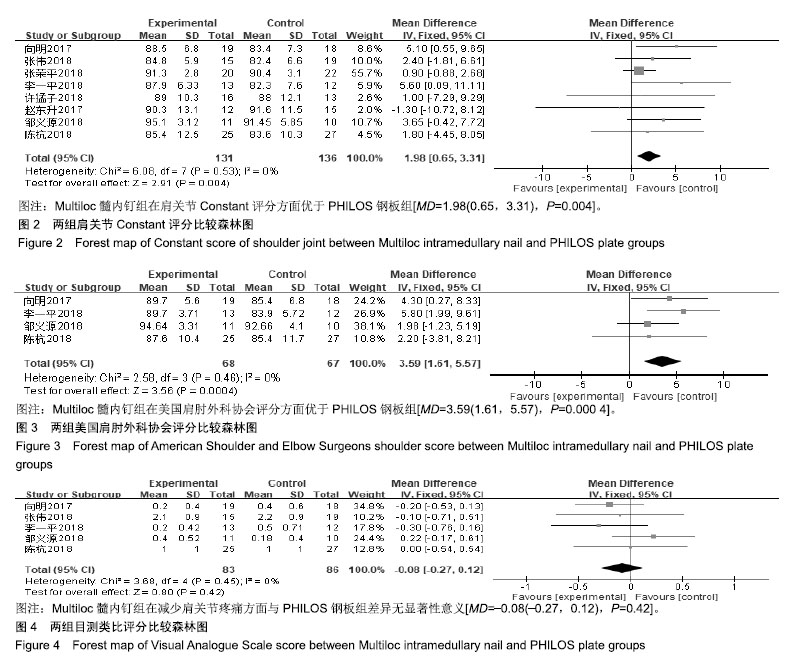

2.2.2 肩关节活动度 (1)肩关节前屈上举活动:共有5篇文献报道了末次随访肩关节前屈上举活动功能[9-10,13-14,16],异质性检验结果提示组间异质性较小(P=0.49,I2=0%),采用固定效应模型合并效应量。Meta分析结果显示,Multiloc髓内钉组在肩关节前屈上举活动方面与PHILOS钢板组相比差异无显著性意义[MD=2.43(-0.46,5.33),P=0.10],见图5。 (2)肩关节外旋活动:共有5篇文献报道了末次随访肩关节外旋活动[9-10,13-14,16],异质性检验结果提示组间异质性较小(P=0.12,I2=46%),采用固定效应模型合并效应量。Meta分析结果显示,Multiloc髓内钉组在肩关节外旋活动方面优于PHILOS钢板组,2组间差异有显著性意义[MD=4.55(2.19,6.91),P=0.000 2],见图6。 (3)肩关节外展活动:共有3篇文献报道了末次随访肩关节外展活动[9-10,16],异质性检验结果提示组间异质性较高(P=0.08,I2=60%),采用随机效应模型合并效应量。Meta分析结果显示,Multiloc髓内钉组在肩关节外展活动度与PHILOS钢板组相比差异无显著性意义[MD=-10.06(-26.74,6.62),P=0.24],见图7。 2.2.3 不良反应 (1)总体不良反应发生率:共有5篇文献报道了总体不良反应事件[11,13-16],异质性检验结果提示组间异质性较小(P=0.70,I2=0%),采用固定效应模型合并效应量。Meta分析结果显示,Multiloc髓内钉组在总体不良反应发生率方面与PHILOS钢板组比较差异无显著性意义[OR=0.95 (0.41,2.18),P=0.90],见图8。 (2)肩峰撞击症:共有3篇文献报道了肩峰撞击事 件[11, 14-15],异质性检验结果提示组间异质性较小(P=0.52,I2=0%),采用固定效应模型合并效应量。Meta分析结果显示,Multiloc髓内钉组在术后肩峰撞击发生率方面与PHILOS钢板组比较差异无显著性意义[OR=2.20(0.60,8.01),P=0.23],见图9。 "


(3)螺钉切出:共有3篇文献报道了术后螺钉切出事件数[11,14-15],异质性检验结果提示组间异质性较小(P=1.00,I2=0%),采用固定效应模型合并效应量。Meta分析结果显示,Multiloc髓内钉组在术后螺钉切出率方面与PHILOS钢板组比较无显著性意义[OR=0.36(0.05,2.37),P=0.29],见图10。 (4)肱骨头坏死:共有2篇文献报道了肱骨头坏死发生事件数[13,16],异质性检验结果提示组间异质性较小(P=0.73,I2=0%),采用固定效应模型合并效应量。Meta分析结果显示,Multiloc髓内钉组在术后肱骨头坏死方面与PHILOS钢板组比较无显著性意义[OR=0.19(0.02,1.68),P=0.13],见图11。 (5)内翻畸形:共有2篇文献报道了内翻畸形发生事件数[11,13],异质性检验结果提示组间异质性较小(P=0.69,I2=0%),采用固定效应模型合并效应量。Meta分析结果显示,Multiloc髓内钉组在内翻畸形方面与PHILOS钢板组比较无显著性意义[OR=0.71(0.11,4.47),P=0.72],见图12。"
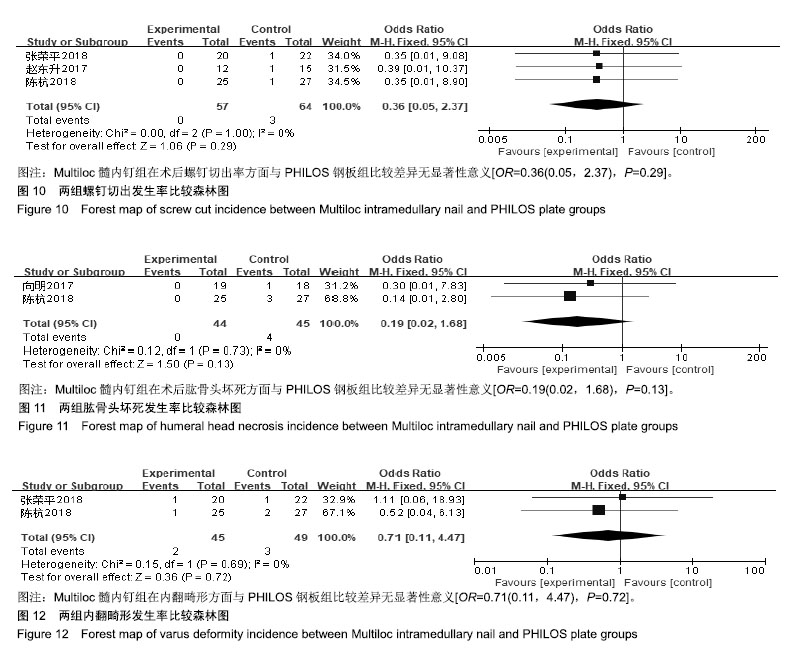

2.2.4 其他方面 (1)手术时间:共有8篇文献报道了手术时间[9-16],异质性检验结果提示组间异质性较高(P < 0.000 01,I2=82%),采用随机效应模型合并效应量。Meta分析结果显示,Multiloc髓内钉组在手术时间方面少于PHILOS钢板组,2组间差异有显著性意义[MD=-13.11(-25.47,-0.74),P=0.04],见图13。 (2)愈合时间:共有6篇文献报道了术后伤口愈合时 间[9-11,13-14,16],异质性检验结果提示组间异质性较小(P=0.20,I2=31%),采用固定效应模型合并效应量。Meta分析结果显示,Multiloc髓内钉组在术后愈合时间方面少于PHILOS钢板组,2组差异有显著性意义[SMD=-0.46 (-0.74,-0.18),P=0.001],见图14。 (3)术中出血量:共有8篇文献报道了术中出血量[9-16],异质性检验结果提示组间异质性较高(P < 0.000 01,I2=96%),采用随机效应模型合并效应量。Meta分析结果显示,Multiloc髓内钉组在术中出血量方面少于PHILOS钢板组,2组差异有显著性意义[MD=-69.44(-102.25,-36.62),P < 0.000 1],见图15。 2.3 敏感性分析 对异质性较高肩关节外展活动、手术时间及术中出血量3个指标采用逐一剔除文献的方法进行敏感度分析,肩关节外展活动在剔除邹义源等[10]的研究后异质性消失,故重新阅读全文,并未发现有文献数据及设计上有缺陷,故不予剔除。其余2项指标逐一剔除单个研究后合并效应值未出现明显改变,说明此次Meta分析结果较为稳健,单个研究对总体效应量所造成的偏倚较小。由于纳入文献小于10篇,漏斗图检验力较低,根据Cochrane手册的推荐,未进行发表偏倚分析。 "
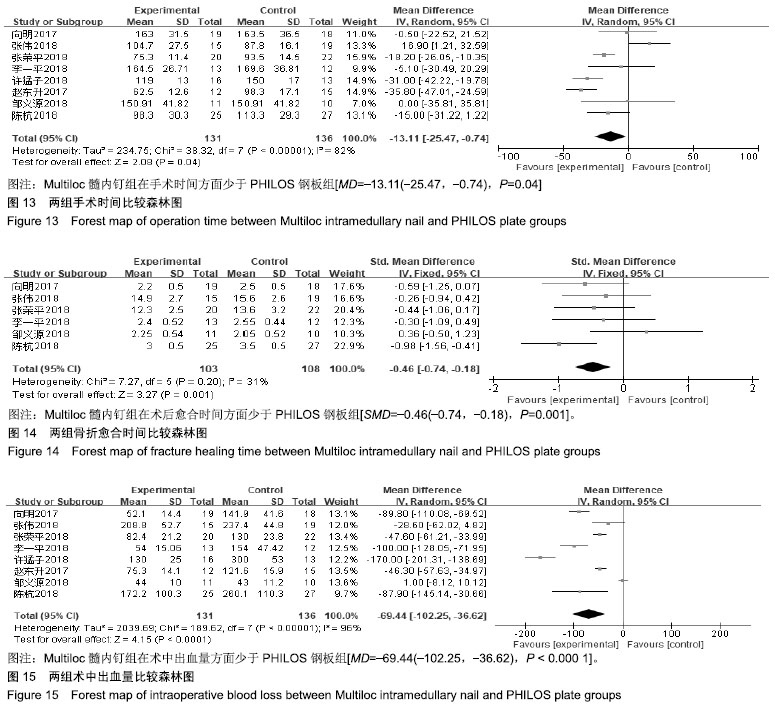
| [1]Bell JE, Leung BC, Spratt KF, et al. Trends and variation in incidence, surgical treatment, and repeat surgery of proximal humeral fractures in the elderly. J Bone Joint Surg Am. 2011;2: 121-131.[2]Palvanen M, Kannus P, Niemi S, et al. Update in the epidemiology of proximal humeral fractures. Clin Orthop Relat Res. 2006;442:87-92.[3]Gracitelli M, Malavolta EA, Assuncao JH, et al. Locking intramedullary nails versus locking plates for the treatment of proximal humerus fractures. Expert Rev Med Dev. 2017;9: 733-739.[4]Hessmann MH, Nijs S, Mittlmeier T, et al. Internal fixation of fractures of the proximal humerus with the multiloc nail. Oper Orthop Traumatol. 2012;4-5:418-431.[5]Gupta AK, Harris JD, Erickson BJ, et al. Surgical management of complex proximal humerus fractures-a systematic review of 92 studies including 4500 patients. J Orthop Trauma. 2015;1: 54-59.[6]Sun JC, Li YL, Ning GZ, et al. Treatment of Three- and Four-Part Proximal Humeral Fractures with Locking Proximal Humerus Plate. Eur J Orthop Surg Traumatol. 2013;6:699-704.[7]Handoll H, Brorson S. Interventions for treating proximal humeral fractures in adults. Cochrane Database Syst Rev. 2015;(11):CD000434.[8]Stang A. Critical evaluation of the Newcastle-Ottawa Scale for the assessment of the quality of nonrandomized studies in meta-analyses. Eur J Epidemiol. 2010;9:603-605.[9]李一平,向明,杨国勇,等.内翻型肱骨近端骨折的治疗:锁定钢板与髓内钉的临床效果[J]. 中国运动医学杂志, 2018,37(11): 945-950.[10]邹义源,向明,陈杭,等.Neer二部分肱骨外科颈骨折微创治疗: Phlios钢板与Multiloc髓内钉对比[J]. 中国组织工程研究, 2018, 22(19):2981-2987.[11]张荣平. Multiloc髓内钉与锁定钢板治疗老年肱骨近端骨折的早期疗效[J]. 临床医学研究与实践, 2018,3(20):54-56.[12]许猛子,周君琳,宋华伟,等.Multiloc髓内钉与Philos锁定钢板治疗肱骨近端骨折疗效对比研究[J]. 国际外科学杂志, 2018,45(3): 168-172.[13]陈杭,向明,胡晓川,等.Philos钢板与Multiloc髓内钉治疗中老年肱骨近端三?四部分骨折的疗效比较[J].中华创伤杂志,2018,34 (12):1067-1074.[14]张伟,范建波,崔志明,等.MultiLoc髓内钉与 PHILOS 钢板治疗肱骨近端骨折的早期疗效比较[J]. 中国骨与关节杂志, 2018,7(11): 811-815.[15]赵东升,郑晓勇,余清文,等.Multiloc髓内针治疗老年肱骨近端骨折的临床疗效[J]. 实用骨科杂志, 2017,23(5):453-455.[16]向明,杨国勇,邹义源,等.锁定钢板与髓内钉治疗肱骨近端骨折的疗效比较[J]. 中华骨科杂志, 2017,37(21):1333-1341.[17]丁国庆,李晓林.老年肱骨近端骨折治疗进展[J]. 国际骨科学杂志, 2011,32(6):372-374, 383.[18]Konrad G, Audige L, Lambert S, et al. Similar outcomes for nail versus plate fixation of three-part proximal humeral fractures. Clin Orthop Relat Res. 2012;2:602-609.[19]林浩东,周军.老年肱骨近端骨折的最佳治疗方案选择[J]. 中国骨与关节杂志, 2018,7(11):801-803.[20]Li M, Wang Y, Zhang Y, et al. Intramedullary nail versus locking plate for treatment of proximal humeral fractures: a meta-analysis based on 1384 individuals. J Int Med Res. 2018; 11:4363-4376.[21]Yoon RS, Dziadosz D, Porter DA, et al. A comprehensive update on current fixation options for two-part proximal humerus fractures. Injury. 2014;45(3):510-514.[22]Sun Q, Ge W, Li G, et al. Locking plates versus intramedullary nails in the management of displaced proximal humeral fractures: a systematic review and meta-analysis. Int Orthop. 2018;3:641-650.[23]Maier D, Jaeger M, Izadpanah K, et al. Proximal humeral fracture treatment in adults. J Bone Joint Surg Am. 2014; 3: 251-261.[24]Burkhart KJ, Dietz SO, Bastian L, et al. The treatment of proximal humeral fracture in adults. Deutsch Arztebl Int. 2013; 35-36:591-597.[25]Wang G, Mao Z, Zhang L, et al. Meta-analysis of locking plate versus intramedullary nail for treatment of proximal humeral fractures. J Orthop Surg Res. 2015;10:122.[26]王伟,陈永佳,沈磊,等.微创钢板内固定与传统手术治疗成人肱骨干骨折的系统评价[J].中国组织工程研究, 2018,22(35): 5715-5723.[27]罗世彤,高宏,刘峰瑞,等.髓内钉与锁定钢板治疗肱骨近端两部分骨折疗效的Meta分析[J].中华创伤杂志, 2016,32(12): 1073-1079.[28]焦庆丰,白鹏程,张媺,等.Philos钢板治疗肱骨近端骨折疗效分析[J]. 临床骨科杂志,2016,19(3):336-337.[29]Lowe JB, Monazzam S, Walton B, et al. How to use fluoroscopic imaging to prevent intraarticular screw perforation during locked plating of proximal humerus fractures: a cadaveric study. J Orthop Trauma. 2015;10:e401-e407.[30]王富强,孙斌,孔凡强.分叉交锁髓内钉与锁定钢板对肱骨骨折患者生物力学比较研究[J]. 中华保健医学杂志, 2018,20(3):203-205.[31]高峰,王秀会,夏胜利,等.锁定钢板与髓内钉治疗肱骨近端骨折的比较[J]. 中国矫形外科杂志, 2018,26(12):1068-1073.[32]余德涛,王雷,邢帧全.锁定钢板与弹性髓内钉对桡神经损伤性肱骨骨折临床疗效比较研究[J]. 检验医学与临床, 2018,15(11): 1640-1643. |
| [1] | Xu Feng, Kang Hui, Wei Tanjun, Xi Jintao. Biomechanical analysis of different fixation methods of pedicle screws for thoracolumbar fracture [J]. Chinese Journal of Tissue Engineering Research, 2021, 25(9): 1313-1317. |
| [2] | Zhang Chong, Liu Zhiang, Yao Shuaihui, Gao Junsheng, Jiang Yan, Zhang Lu. Safety and effectiveness of topical application of tranexamic acid to reduce drainage of elderly femoral neck fractures after total hip arthroplasty [J]. Chinese Journal of Tissue Engineering Research, 2021, 25(9): 1381-1386. |
| [3] | Chen Xinmin, Li Wenbiao, Xiong Kaikai, Xiong Xiaoyan, Zheng Liqin, Li Musheng, Zheng Yongze, Lin Ziling. Type A3.3 femoral intertrochanteric fracture with augmented proximal femoral nail anti-rotation in the elderly: finite element analysis of the optimal amount of bone cement [J]. Chinese Journal of Tissue Engineering Research, 2021, 25(9): 1404-1409. |
| [4] | Du Xiupeng, Yang Zhaohui. Effect of degree of initial deformity of impacted femoral neck fractures under 65 years of age on femoral neck shortening [J]. Chinese Journal of Tissue Engineering Research, 2021, 25(9): 1410-1416. |
| [5] | Zhang Chao, Lü Xin. Heterotopic ossification after acetabular fracture fixation: risk factors, prevention and treatment progress [J]. Chinese Journal of Tissue Engineering Research, 2021, 25(9): 1434-1439. |
| [6] | Zhou Jihui, Li Xinzhi, Zhou You, Huang Wei, Chen Wenyao. Multiple problems in the selection of implants for patellar fracture [J]. Chinese Journal of Tissue Engineering Research, 2021, 25(9): 1440-1445. |
| [7] | Wang Debin, Bi Zhenggang. Related problems in anatomy mechanics, injury characteristics, fixed repair and three-dimensional technology application for olecranon fracture-dislocations [J]. Chinese Journal of Tissue Engineering Research, 2021, 25(9): 1446-1451. |
| [8] | Chen Junming, Yue Chen, He Peilin, Zhang Juntao, Sun Moyuan, Liu Youwen. Hip arthroplasty versus proximal femoral nail antirotation for intertrochanteric fractures in older adults: a meta-analysis [J]. Chinese Journal of Tissue Engineering Research, 2021, 25(9): 1452-1457. |
| [9] | Chen Jinping, Li Kui, Chen Qian, Guo Haoran, Zhang Yingbo, Wei Peng. Meta-analysis of the efficacy and safety of tranexamic acid in open spinal surgery [J]. Chinese Journal of Tissue Engineering Research, 2021, 25(9): 1458-1464. |
| [10] | Hu Kai, Qiao Xiaohong, Zhang Yonghong, Wang Dong, Qin Sihe. Treatment of displaced intra-articular calcaneal fractures with cannulated screws and plates: a meta-analysis of 15 randomized controlled trials [J]. Chinese Journal of Tissue Engineering Research, 2021, 25(9): 1465-1470. |
| [11] | Huang Dengcheng, Wang Zhike, Cao Xuewei. Comparison of the short-term efficacy of extracorporeal shock wave therapy for middle-aged and elderly knee osteoarthritis: a meta-analysis [J]. Chinese Journal of Tissue Engineering Research, 2021, 25(9): 1471-1476. |
| [12] | Wang Yongsheng, Wu Yang, Li Yanchun. Effect of acute high-intensity exercise on appetite hormones in adults: a meta-analysis [J]. Chinese Journal of Tissue Engineering Research, 2021, 25(8): 1305-1312. |
| [13] | Zeng Yanhua, Hao Yanlei. In vitro culture and purification of Schwann cells: a systematic review [J]. Chinese Journal of Tissue Engineering Research, 2021, 25(7): 1135-1141. |
| [14] | Kong Desheng, He Jingjing, Feng Baofeng, Guo Ruiyun, Asiamah Ernest Amponsah, Lü Fei, Zhang Shuhan, Zhang Xiaolin, Ma Jun, Cui Huixian. Efficacy of mesenchymal stem cells in the spinal cord injury of large animal models: a meta-analysis [J]. Chinese Journal of Tissue Engineering Research, 2021, 25(7): 1142-1148. |
| [15] | Xu Yulin, Shen Shi, Zhuo Naiqiang, Yang Huilin, Yang Chao, Li Yang, Zhao Heng, Zhao Lu. Biomechanical comparison of three different plate fixation methods for acetabular posterior column fractures in standing and sitting positions [J]. Chinese Journal of Tissue Engineering Research, 2021, 25(6): 826-830. |
| Viewed | ||||||
|
Full text |
|
|||||
|
Abstract |
|
|||||

